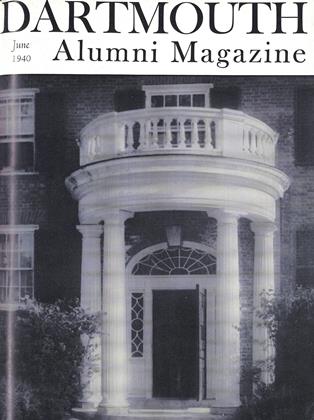FIRST DARTMOUTH CLASS to graduate after the onset of the depression, the Class of 1930 on the eve of its tenth reunion has taken stock of itself in a collective autobiography being published under the title Where Oh Where? Based on reports from 454 men (91% of the active members of the class), the picture of the composite '30 man today is about as follows:
He is a man in business, making about $3,300 a year, who was married five or six years after graduation and now has one child. He is renting an apartment or house in a large city or suburb, yearning to own his own home, keeping up his exercise with an occasional game of golf or tennis, belonging to at least one club, and reading and playing cards for relaxation. He is a Republican, voting regularly, disapproving of President Roosevelt's policies, and hoping to stay out of war. He would definitely go to college again if he had to repeat, and would again pick Dartmouth 9 to 1; he will probably urge his sons and the neighborhood kids to make the same choice.
Dartmouth '30 has gone 65% into business, which is high compared to 58% by Yale '29 and 51% by Harvard '24, whose earlier class biographies offer interesting comparisons. The class has gone 10% into law, 8% into medicine, 8% into education, 4% into arts and letters, 4% into government, and 0.2% into the ministry. Four out of five men expect to remain at their present jobs, although only half are doing what they hoped to be doing when in college.
Dartmouth '30's median salary of $3,305 compares with $3,361 for Harvard '24 six years ago and $3,539 for Yale '29 last year. The men in education, government, arts and letters are at the lower end of the salary scale, with less than $3,000 a year, while those in mining and raw materials and in medicine are the most prosperous group, averaging above $4,000.
The relation of college grades to present salaries—which the report disavows as signs of "success" but accepts as convenient evidence of "getting along in the world"—shows that men who had a four-year average of less than 2.0 are not doing quite so well as those above, but that a 2.5 average seems as good as 3.5 or 4.0, as far as earning power goes. Non-graduates are doing better than graduates with only average grades, but the report points out that length of service is still an important factor ten years out. This factor also applies to the 50% of the class which went into graduate work and at present earns less than those without graduate training.
In the Class of 1930, at least, the former Big Men on Campus show consistently higher average salaries, with Palaeopitus leading the entire class with a median salary of over $6,000. Three-sport men are doing best among the athletes, while the human dynamos in non-athletic activities rank well up. Captains and managers are also well above the class median.
Four out of five '30 men are married. They have neatly produced one child apiece, in contrast to unsightly fractions which usually appear in statistical studies. Married educators lag behind with .57 of a child each, while the manufacturers are leaders with 1.28 children each.
Dartmouth '30 has a Republican hue all its own, its ratio of 5.18 Republicans to 1 Democrat being unusually high. Party allegiance is more closely allied to occupation than salary, most of the Democrats coming from the ranks of government workers, educators, doctors and lawyers. President Roosevelt himself fared better than any of his policies, among which federal finance and business policy were most strongly condemned.
If the United States entered the European war, 70% of the class would fight only if drafted, 14% would fight willingly (only 9% of the undergraduates said they would last fall), 10% would refuse to fight, and 6% would enlist only because of social pressure.
 View Full Issue
View Full Issue
More From This Issue
-
 Article
ArticleGordon Ferrie Hull
June 1940 By STEARNS MORSE PROFESSOR OF ENGLISH -
 Article
ArticleIn Reply to Mr. Qua
June 1940 By Judicial Temperament, JOHN G. GAZLEY -
 Sports
SportsBig Green Teams
June 1940 By Whitey Fuller '37 -
 Class Notes
Class Notes1915*
June 1940 By CHARLES R. TAPLIN, RUSSELL B. LIVERMORE -
 Class Notes
Class Notes1931*
June 1940 By CHARLES S. McALLISTER, CRAIG THORN JR. -
 Class Notes
Class Notes1930*
June 1940 By ALBERT I. DICKERSON, G. WARREN FRENCH
Article
-
 Article
ArticleFRESHMAN STATISTICS
January, 1914 -
 Article
ArticleDARTMOUTH AND THE AMERICAN UNIVERSITY UNION IN PARIS
February 1918 -
 Article
ArticleThe Magazine
October 1976 -
 Article
Article'40 Rediscovers Dearie McGowen
FEBRUARY • 1988 By Dick Bowman '40 -
 Article
ArticleDr. Wheelock's Journal
MAY 1992 By Wheelock -
 Article
ArticleThayer School
February 1952 By William P. Kimball '29


